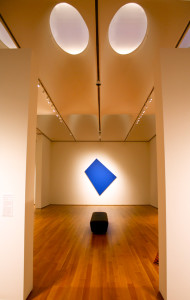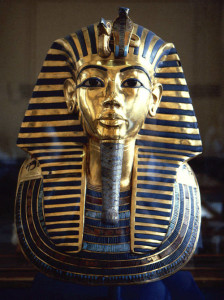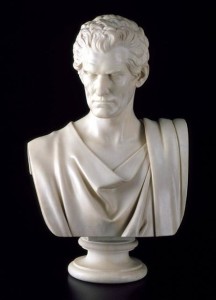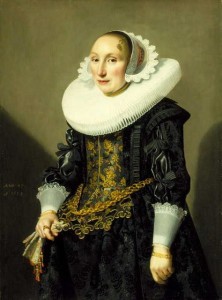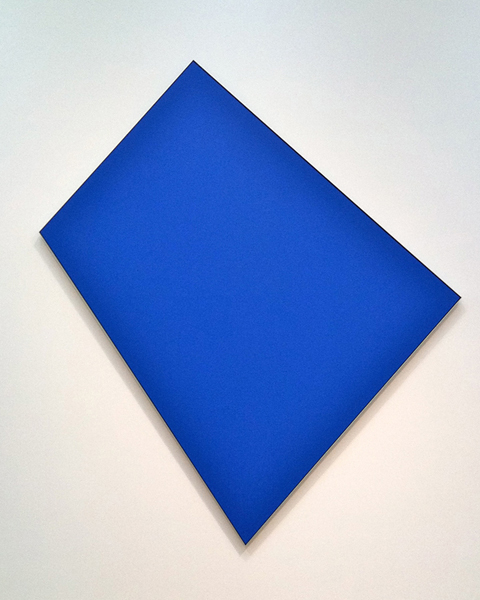
Blue Panel
Ellsworth Kelly, American, 1980
(oil on canvas)
North Carolina Museum of Art, Raleigh
The next three entries are for the advanced student who wants to try and answer the question, “What is art?”
What is art? Think about this for a moment. What makes art, art? Does art have to be beautiful? Does art have to mean something? Does art have to tell a story? Does art have to have recognizable forms or details? Who decides what makes art, art?
Let’s take a look at a work by the American artist Ellsworth Kelly and try to answer a few of these questions. First, describe what you see. What do you notice first? Perhaps what you notice first about this work is that it is a beautiful shade of blue. Perhaps you notice it has a geometric form. Since it has four sides and four corners, it is a quadrilateral. Is the form evenly balanced or is it skewed? It is skewed. When shapes are skewed like this we call them asymmetrical. Color and shape are two elements of art. Do these elements make you feel a certain way? How so? Is the blue color serene? Quiet? Loud? Does the skewed shape appear to be at rest? In motion? What about the space around this work? The wall behind this work is white. Would your reaction change if the wall behind it were a different color? What if the work were a color like hot pink instead of blue? Would that make you feel differently? What if the work were a different shape? What if it were a perfect circle instead of a quadrilateral? Would a different shape make you feel differently? What if the form were symmetrical instead of asymmetrical? Would your reaction to it change? In what way?
This work has a recognizable form and a recognizable color, but does it have any details? No, it doesn’t. Does this mean it isn’t art? At one time, only art that looked real and had a lot of details was valued. Even today, many people think art should have a lot of details and be a true-to-life depiction of a real object. But if you follow the entries in this blog, you already know that art can have a lot of details, it can have a few details, or it can have hardly any details at all. Artists who make art with few details can be just as talented as artists who make art with many details. Artists make art in different ways and in different styles, in part because their environment and time make their work different from the work of other artists in other cultures, times and places.
Does art have to tell a story? What do I mean? In the past, art would often tell stories from the Bible, stories about real events in history, or myths about the lives of heroes and gods and goddesses from ancient Greece and Rome. Do you know what myths are? Myths are stories that often try to explain how the world and humankind came to be. Look carefully. Does this work tell a story or a myth? No, it doesn’t. It is simply an expression of color and shape. Yet, like art that tells stories, this work makes us feel a certain way when we look at it, doesn’t it? In fact, if you look carefully, this skewed, blue quadrilateral may make you think about your own experiences and the things that are most important to you. Is it beautiful? Look carefully. What do you think? It may or may not be beautiful. Each one of us must decide what is or is not beautiful. Sometimes what one person thinks is beautiful, another person thinks is ugly. Lastly, who decides what makes art, art? Who decided this work was a piece of art? Other artists? Dealers who sell art? Collectors who buy art?
Let’s return to our main question, “What is art?” At first thought, art seems to be about power. Throughout the centuries, artists have represented people in power. What is power? At the most basic level, power is one person’s ability to control or influence the behavior or thoughts of other people. How do certain people attain power, maintain power, and then perhaps lose power in different cultures? Is power always just, or is it sometimes unjust? Do powerful people sometimes exert force to control others? When this happens, how do others react? Do conflicts such as wars sometimes arise, because people wish to change how authority is delegated? Besides force, how do leaders influence others and wield power? Does art play a role in a leader’s ability to influence others? Let’s examine how leaders use art as a tool to gain and maintain power.
Can you think of any works of art in which the person being portrayed tried to influence how others thought and felt? What about art from long ago? What about ancient Egyptian art? Close your eyes for a moment and imagine a funerary object made for the mummified body of an ancient Egyptian pharaoh (king). What materials is it made from? Open your eyes. Here is the death mask for the mummy of the boy-pharaoh, King Tutankhamun. In ancient Egypt, death was regarded as a crossing point between two lives. It was believed that after death, King Tutankhamun would live on in the afterlife as a pharaoh and so his tomb needed to be filled with everything he would need, including thrones, jewelry and chariots as well as furniture and food. This boy-pharaoh—King Tut, as he is called—is well known due to the wealth of the objects that were found in this tomb. He ruled for about nine years and died when he was only eighteen years old.
King Tut had three burial coffins, each one placed inside the other, and a death mask that were made of precious materials. His death mask was placed directly on the face of his mummified body. The three coffins were housed inside a large sarcophagus. Kings Tut’s innermost coffin was made of a quarter ton of beaten gold and inlaid with semiprecious stones such as lapis lazuli, turquoise and carnelian. His death mask was made of two sheets of gold and inlaid with colored glass, carnelian and lapis lazuli. For the ancient Egyptians, gold was believed to have magical powers, because it did not tarnish nor deteriorate. It shone like the sun and represented the power of their ancient sun god. What do you notice about King Tut’s death mask? He is wearing the false beard of Osiris! In ancient Egyptian belief, Osiris was a powerful ruler and god of the underworld. By wearing the false beard of Osiris, King Tut was telling his subjects that, like Osiris, he had achieved an eternal place in the afterlife. Religious practices and mythology centered on the pharaoh and played a major role in how he or she wielded power. The role of art was to show the pharaoh at the nexus of the religious beliefs of the community. Look closely. Attributes like the false beard and the use of precious materials such as gold for King Tut’s coffins and his death mask show that as pharaoh, he was a person of immense power and wealth—in this life and in the next.
Let’s look at another example.
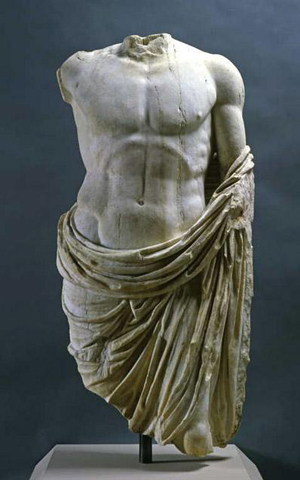
Torso of an Emperor in the Guise of Jupiter, Roman, 1st century (marble)
North Carolina Museum of Art
Here we have a 2000-year-old ancient Roman statue. When ancient Rome came to power, it copied the art of ancient Greece, borrowed its gods, and imitated its representative government. Gradually, strong single leaders called emperors ruled and the nation became a military empire. At its height, the Roman Empire ruled over a vast territory. It ruled over a territory from England to the Persian Gulf and the Caspian Sea and controlled the lives of people from all over the world, including Greeks, Egyptians, Africans, Jews and Christians. Do you know some achievements and practices of the ancient Romans? Roman aqueducts carried water. Hard-surfaced roads tied the territory together. Stonewalls kept out barbarians. Roman citizens relaxed in heated baths. Shrines and monuments were raised to their gods. Arches were built. Fifty thousand spectators sat in the Coliseum and watched gladiators and beasts battle it out.
Perhaps this is a fragment of a statue of a Roman emperor. Just as equally, it could be a fragment of a statue of a Roman citizen, perhaps a general. We do know that when the sculpture was made, it stood almost eight feet tall. If of a Roman emperor, it would have been placed in a public area, perhaps in a forum of a city. Describe him. He is larger than life and has a mantle draped around his lower body. Describe his torso. He is strong and muscular and by extension powerful. His pose is characteristic of how the god Zeus was portrayed in ancient Greece. Who is Zeus? Zeus is the father of the gods and men in the belief system of the ancient Greeks. He is the god of thunder and the sky. The ancient Romans called him Jupiter. Equally likely, this sculpture could be a likeness of Jupiter himself, in which case it would have had accompanying attributes such as an eagle and lightning bolt (now missing).
Roman emperors often had statues of themselves done in the guise of Jupiter. Let’s assume this is a statue of a Roman emperor. Why would a Roman emperor want to look like the king of the gods? By associating himself with the king of the gods, an emperor would have sent a message to his subjects that not only was he a powerful ruler. He was as powerful as the most powerful of gods! In this way, every Roman citizen who walked in the Roman forum would have seen his sculpture and would have acknowledged the emperor’s divine status and power. Similarly, a statue of a general in the guise of Jupiter would have reminded others of the general’s prowess and greatness.
What about an example from the more recent past?
Here we have a bust of John C. Calhoun (1782-1850). Calhoun was a leading politician from South Carolina before the time of the American Civil War (1861-1865). What can you tell me about the American Civil War? The motivations for the American Civil War were complex. It was a devastating war that pit citizen against citizen. Calhoun is best known for his defense of states rights and slavery and pointing the South toward secession from the Union. What was the secessionist movement? In the face of mounting sentiment in the North to end slavery and set slaves free, eleven of the fifteen southern states where slavery was legal declared they were no longer a part of the United States and instead joined together as the Confederate States of America. This was the start of the American Civil War—the war between the North and South. The movement collapsed in 1865 when the Confederate States of America surrendered to the northern states and slavery was abolished.
Calhoun was nicknamed the “cast iron man” for the rigidity of his ideas and his oratory skill. Was the artist successful in conveying Calhoun’s formidable nature? How so? Does he have a stern expression on his face? Look at how his eyebrows are knitted, his eyes are focused, and his lips are pressed tight. Is there anything unusual about how he is dressed? He is wearing the toga of an ancient Roman senator or philosopher. By connecting Calhoun to powerful men of the past—the philosophers and statesmen and orators of ancient Rome—the artist is telling the viewer that Calhoun was an intelligent and powerful man. While the reputation of historical figures rests in the hands of contemporary viewers who must forever reassess the past, the severe expression on Calhoun’s face bespeaks a formidable and ironclad will. Indeed, he looks like a man staring down his opponents and one who could easily influence others. If you look carefully, you can see the marble is stained in places. At one time, this bust of Calhoun was installed in the Senate Chamber of the State Capitol in Raleigh, North Carolina. During the Civil War, after the Confederacy collapsed, Union troupes, under the command of General Sherman, moved into Raleigh. During the time of occupation, someone, probably a Union soldier, entered the ransacked Capitol and dumped ink over the crown of the bust, causing the ink to stream down the face and stain the marble forever. Remember this. It is only one example out of many examples in the history of art that speak to the power of art.
Admittedly, there seems to be an endless number of examples in the history of art that illustrate the role that art can play in relation to power. I would like to highlight one last example. During the 1600s in Europe, an affluent and well-educated middle-class emerged. At this point, the ability to use art as a tool in which to influence others was given to a great number of people. Scores of portraits were commissioned. These works elevated the status of individuals and gave them a kind of power and immortality not unlike the Death Mask of Tutankhamen, the Torso of an Emperor and John C. Calhoun gave King Tut, a Roman emperor and a politician a claim to power and immortality. Let’s take a look.
Here we have a portrait of Adriana van der Aa. The artist Jan Daemen Cool portrays a woman who is modest and religious and at the same time comfortably middle-class, as we can see by all her finery. Indeed, although Adriana is wearing a slightly out-dated large millstone ruff collar, the rest of her costume is a document of the high fashions of the day. She is wearing a double cap on her head, lace cuffs, a sleeveless vest, a bodice embroidered with floral designs, skirt with floral designs, and cut sleeves tied with silk ribbons. She is also wearing a heavy chain across her bodice, a necklace, rings, bracelets, and a hatpin. In her right hand she holds a pair of kid gloves decorated with embroidery, ribbons, pearls and a chain. Since a full length pose would show the sin of pride, as would a view of land in the background, the artist has shown Adriana against a dark background in a three-quarter-length pose to convey her humility. In short, Adriana reveals herself to be an affluent, middle-class woman as well as a humble servant of God. Her image communicates her station in life to her peers and shores up her power and status.
As all of these examples illustrate, the history of art seems to be one in which leaders and those who have power and wealth portray themselves and their beliefs in ways that support and enhance their power and status. This may lead some of you to conclude that we have answered our question about the nature of art satisfactorily. It is obvious you say, “Art is about power!” Perhaps. Perhaps not. Let’s end our discussion for now. We will revisit the topic in the next entry. Be sure to follow along when we continue to ask the question, “What is art?”
§
Would you like to see Blue Panel, Torso of an Emperor, John C. Calhoun and Adriana van der Aa in person? All you have to do is visit the North Carolina Museum of Art in Raleigh, North Carolina. Blue Panel is in the Modern galleries at the museum. Torso of an Emperor is in the Classical Court. John C. Calhoun is in the American galleries. Adriana van der Aa is in the European galleries. The Death Mask of Tutankhamun is at the Egyptian Museum in Cairo. For most of us, going to Egypt is but a dream. We will have to be content with seeing this amazing work on our computers and in books. If you would like to visit the North Carolina Museum of Art, tours of the collection are given daily, except for Monday when the museum is closed to the public. Or you can contact the museum ahead of time and arrange for you and your friends to have a private tour. I’m sure a docent at the museum would be happy to show you and your friends the many works of art. Whether you visit the North Carolina Museum of Art on your own or have a tour with a docent, it will be well worth your time!
